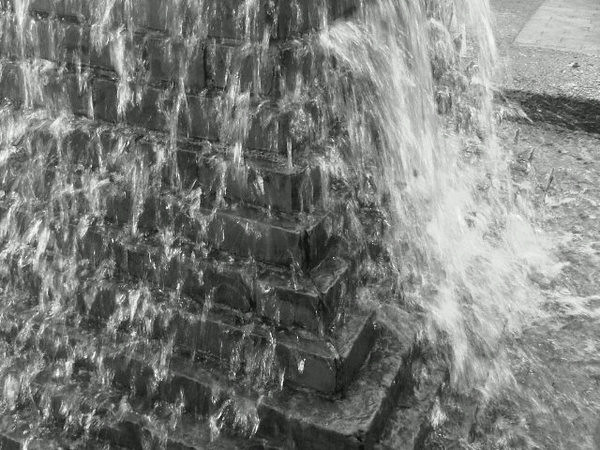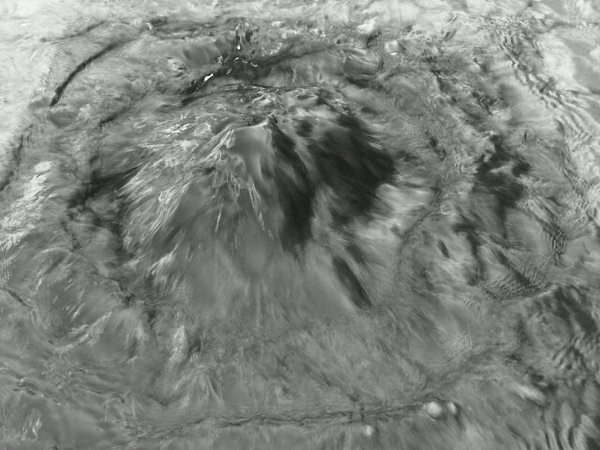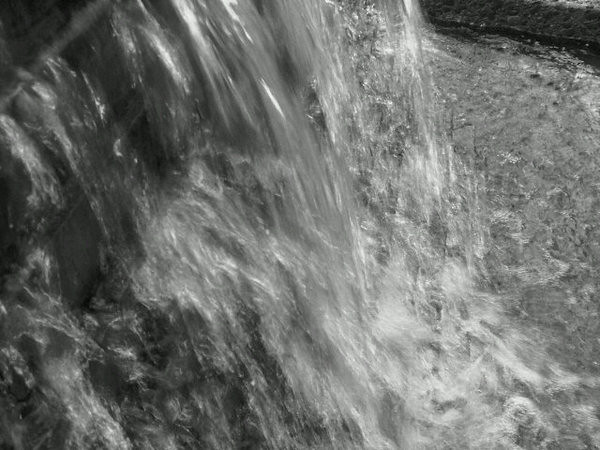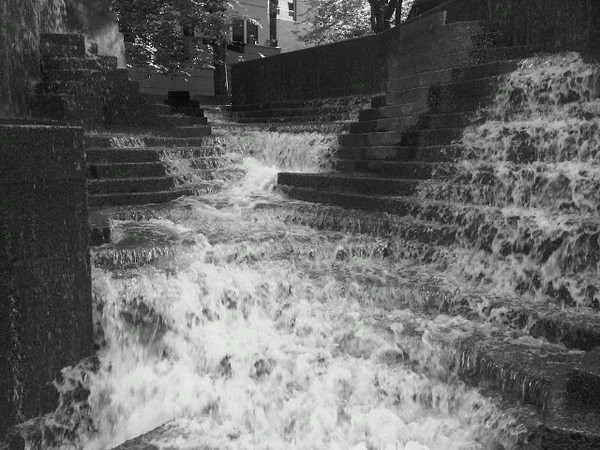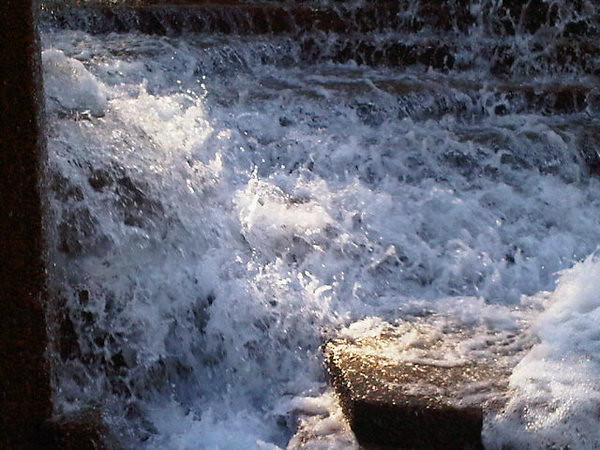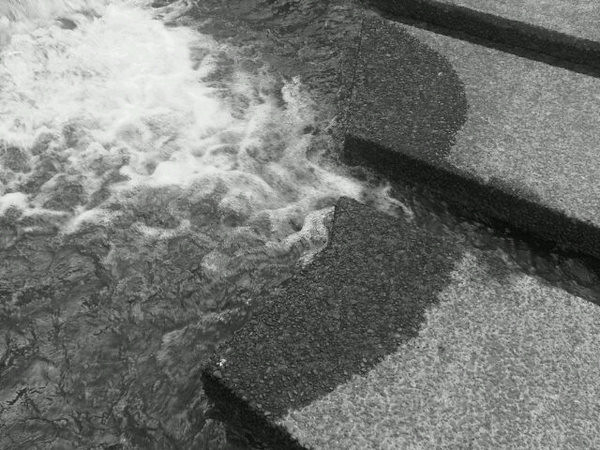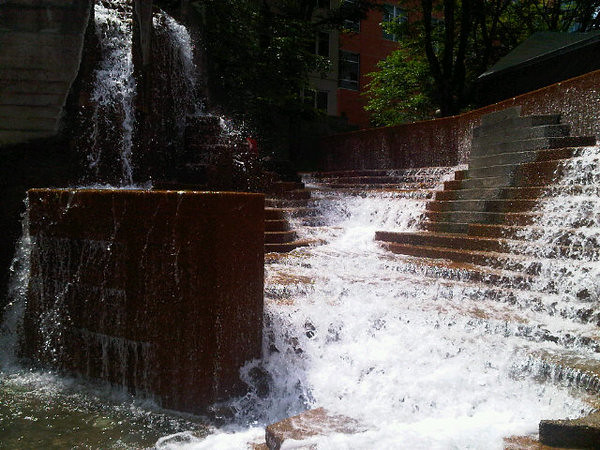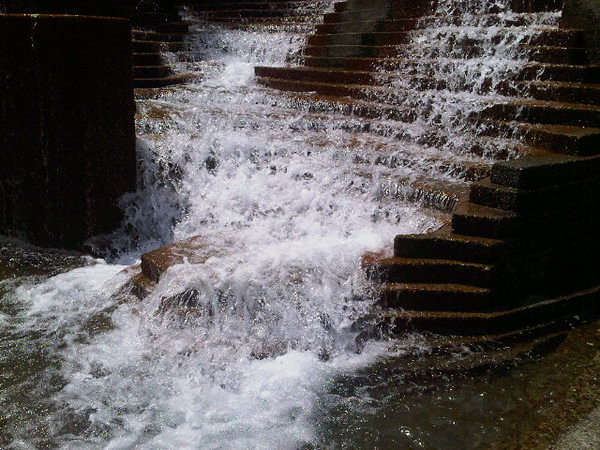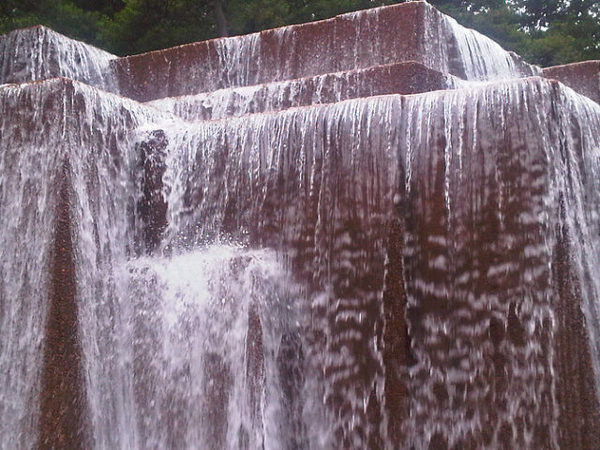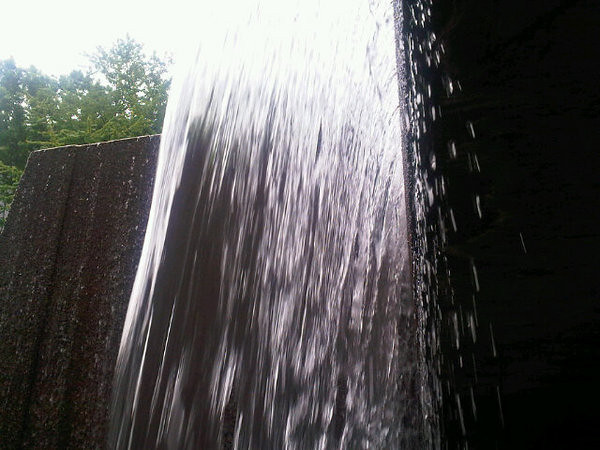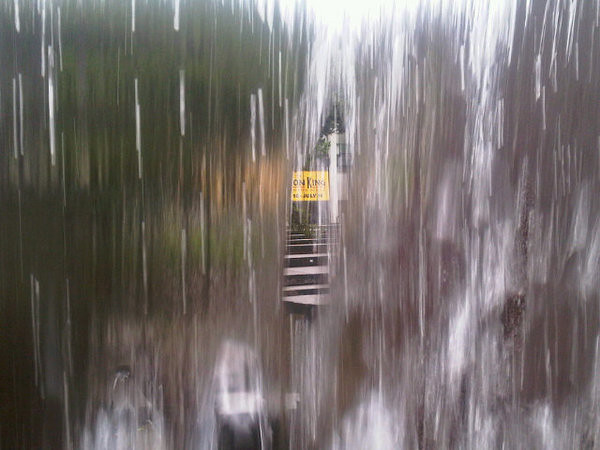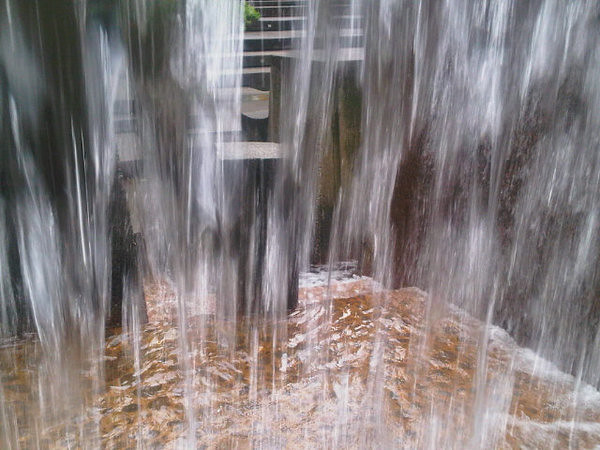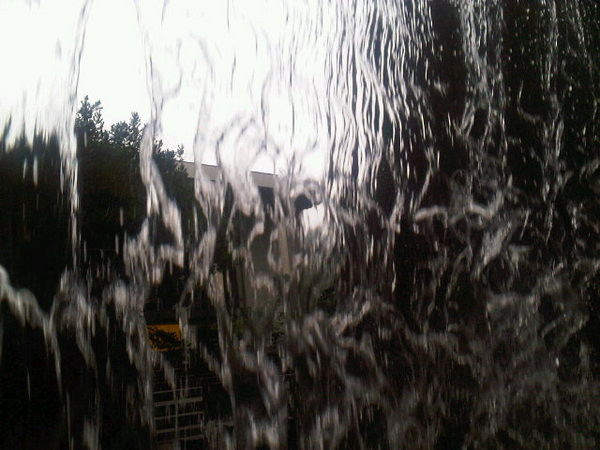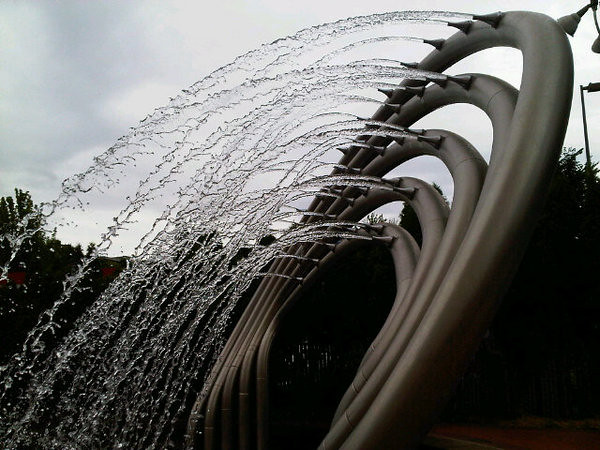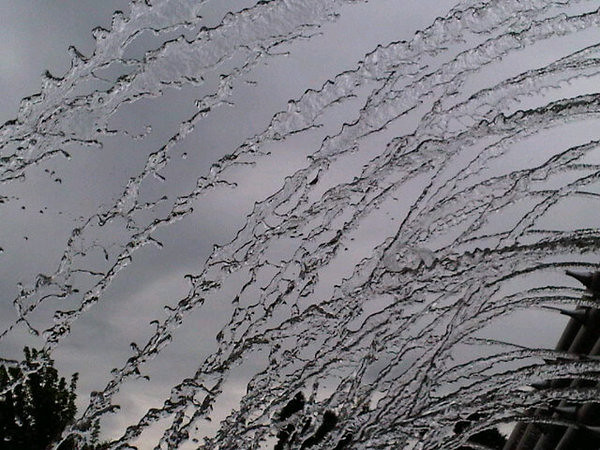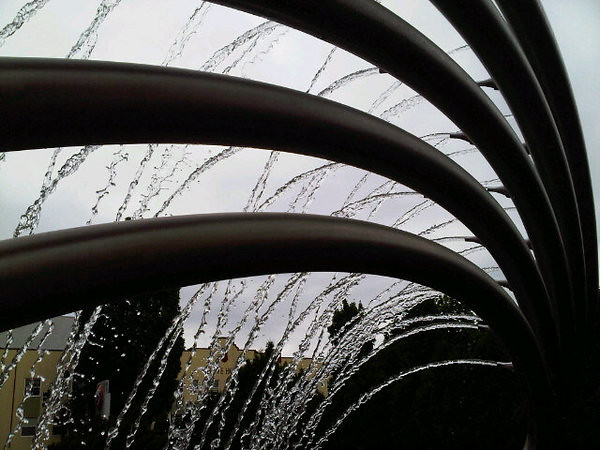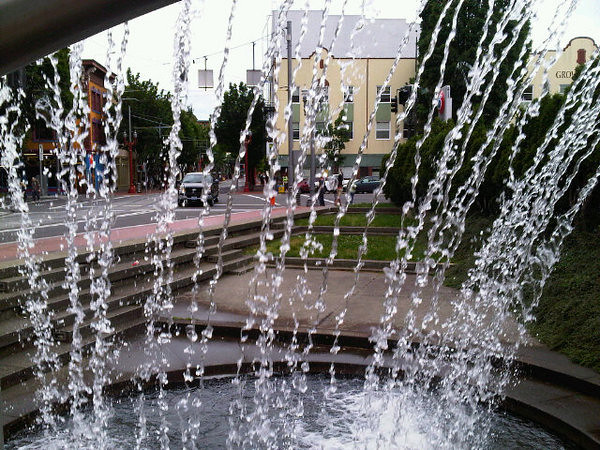View Larger Map
It occurred to me recently that I'd never done a post about SW Portland's Duniway Park even though it's more or less in my neighborhood, on Barbur just outside I-405. I figured I could rectify that, since had a few photos of the park lying around, and more importantly the library's Oregonian database to rifle through. The park's best known today for its running track, but there's more to it than that, and the area has an interesting history.
Suppose you were standing at the Duniway Park track and were transported a century back in time to the year 1913, possibly thanks to a new Nike shoe with a flux capacitor in the heel. You would recognize absolutely nothing about the area. You'd also fall a substantial distance, and you wouldn't like what you landed in.
The present-day park is laid out as couple of flat terraces with a steep slope between them: The lower one containing the main running track, and the upper one another running course, some picnic facilities, and the park's lilac garden. The ground drops steeply again on the other side of Barbur. (The adjacent ivy-choked forest is also part of the park, but it's not the interesting part for our purposes here.) West of the park along Sam Jackson Park Road is a canyon formed by Marquam Creek, which flows down out of the West Hills and into a pipe, flowing deep under Duniway Park and on to the Willamette River. Looking around today's park, there's nothing to suggest there was ever a creek here.
It's hard to imagine this now, but Duniway Park was once Marquam Gulch, a steep gully at the south edge of downtown Portland. A high railroad trestle crossed the gulch at 4th Avenue, where today's Barbur Boulevard now runs. Like much of South Portland in those days, Marquam Gulch was a poor Italian and Jewish immigrant neighborhood, with little houses clinging to the sides of the gulch. It also served as a municipal garbage dump, of an unclear degree of officialness. It's unclear whether it was a neighborhood first and then a city dump, or vice versa, or both at the same time, which I can't rule out considering the time period. Presumably there's still a layer of century-old garbage down there somewhere, preserved for future archeologists.
A few links about the bad old days of Marquam Gulch:
- An Oregon Historical Society page about immigrant groups in the early 20th century. I'm always leery of accounts that generalize "The Russian Jews did X, while the Italians did Y", but it's an interesting article nonetheless.
- A Portland Police Museum account of a 1907 homicide case gives a sense of what the Marquam Gulch area was like at the time. The page includes an 1885 photograph showing the old 4th Street Bridge, which carried pedestrians and a long-vanished railroad over the long-vanished gulch. The route of the old railroad became today's Barbur Boulevard, so the location of the old bridge is now the eastern edge of Duniway Park. The whole situation is kind of hard to visualize.
- An old 1909 USGS publication, Structural Materials in Parts of Oregon and Washington, notes there were also rock quarries operating in Marquam Gulch at the time.
- The neighborhood in Marquam Gulch may not have been strictly legal. A brief Oregonian item from April 1893 mentions the O.R.& N. railroad trying to keep squatters off its Marquam Gulch land. The court case at hand concerned accusations of trespassing against a gentleman referred to simply as "An Italian, with an unpronounceable name."
- The 1904 tale of a stabbing in Marquam Gulch, which began with children arguing over a bag of peanuts, and which escalated into an adult knife fight, though it's possible ill feelings betwen the two familes extended further back to the old country. The victim and perpetrator were both Italian, and the Oregonian luridly claimed that "VENDETTA COMES TO OREGON".
- Officially sanctioned dumping began around 1914. It was argued that Seattle was dumping garbage in gullies already, and it was working out ok for them, even in nice neoghborhoods. And more importantly, it was cheaper than building a new garbage incinerator, though that eventually happened at what's today's Chimney Park. Property owners were already outraged by October of that year, claiming the stench from the Marquam Gulch dump was intolerable, and the city had unwisely promised no odors.
- Illegal dumping was prevalent as well. An item from March 1915 explains that one offender was caught when she dumped a pile of rubbish in the "forbidden grounds" of Marquam Gulch that included letters addressed to her. In related news, let's all agree that City Sanitary Inspector Salisbury had quite a thankless and disgusting job.
- A 1910 proposal would have run a railroad spur up Marquam Gulch, enabling the creation of a new warehouse district there, thus improving an area the paper called "practically worthless". Nothing seems to have come of the proposal.
The conditions at Marquam Gulch led to calls for reform of some sort or other. In 1916, local schoolchildren were recruited to write letters to the city council, begging for a proper playground so they didn't have to play in the gulch or in the street:
Mike Sholkoff writes in part: "In South Portland there are many children killed every year. The children pick things out of the dumps and sell them to the junk man for 5 and 10 cents, and then have to pay hundreds of dollars for doctor bills. A playground would cost about $60,000, but that isn't much when it saves many chidren's lives. Portland is the second cleanest city, but if the gulch were gone it could come first."
"Honorable Mayor and Commissioners," writes Harold Johnson, "I think that South Portland should have a playground for the following reasons: There is no place for us children to play except in the streets and you know that isn't 'safety first.' Just about the time that we have a good game going the cop comes along and chases us away. If you can't give us a playground take away the cops. It wasn't so bad while the cops walked, but you can't tell one Ford from another until a cop jumps out. Just think if you were a boy how much better it would be to have a playground than to play in the streets. I am willing to work for it."
This and similar efforts eventually led to today's park, which was dedicated (in a partially built state) in August 1918. A November 1919 article "Dream of 20 Years is Realized in Duniway Park", explains the long history of the project, with a map of the planned facilities, and a photo of the Southern Pacific trestle where Barbur is now. The project was funded by a voter-approved 1917 parks levy, which specified fixing Marquam Gulch as a top priority. It was originally proposed to name the park for Mrs. J.F. Kelly, who campaigned to create it. She declined the honor, however, and asked that they let her name the park instead, and "Duniway Park" was her choice.
Duniway Park is still one of a very short list of Portland city parks named for women. Named for Abigail Scott Duniway, a notable women's suffrage activist of the early 20th century. Others include the new Elizabeth Caruthers Park in the South Waterfront, and Vera Katz Park in the Pearl District. The latter isn't really a city park, per se, but I'm having to stretch the definition just to bring the list up to three. Although obviously there may be some I'm not aware of.
Duniway's brother, Oregonian editor Harvey Scott, was deeply opposed to her suffrage campaign, and the two feuded bitterly. Despite being wrong about a broad range of social issues of the day, Scott was memorialized with a smug-looking statue near the top of Mt. Tabor.
I haven't come across any mention of what became of the gulch's previous residents. As far as I can tell, the Oregonian didn't see fit to report on that little detail, much less inquire into why there were so many desperately poor people in the city.
The newly created park still didn't resemble today's park. Much of the park was below the grade of SW Barbur, and most of it consisted of baseball fields. A 1938 aerial photo at Vintage Portland shows the old gulch partially filled in, and the old trestle replaced with an earthwork structure to carry Barbur. A 1934 photo gives another view of the site of the present-day running track.
All of this reworking and reimagining hasn't done wonders for the local street grid. A page about the Marquam Gulch area at ExplorePDX digs into this and discusses why current maps of the area often sport inaccuracies, including roads that don't actually exist in the real world.
When World War II broke out a few years later, the Oregon National Guard camped in Duniway Park & the South Park Blocks in 1943. Not because of World War II necessity, but as part of a PR exercise coinciding with the movie premiere of Irving Berlin's This is the Army (which is on YouTube here). The park was used again for the same purpose (but without a movie premiere) in 1944; the Oregonian ran two photos from the encampment, one of GIs peeling potatoes, and the other of soldiers marching through mud lugging enormous duffel bags.
The current layout of the park dates to 1965 in an agreement between the city & Portland State College (now Portland State University). The agreement allowed PSC to use part of the park as team practice facilities, but without the city giving up title to the land. The land was raised to its current level at this point; the article mentions "Most of the fill material will be donated and will be from excavations for the Foothills Freeway", better known as Interstate 405. The running track went in at this point, and the baseball fields were removed.
In 1970 this was the staging area for a big protest march, part of the People's Army Jamboree, an event opposing the national American Legion convention in town. The Jamboree was smaller than first envisioned because the state government-sponsored Vortex One music festival drew many of the city's hippies and freaks and longhairs away to frolic at Milo McIver State Park on the Clackamas River near Estacada. This march became known for a nationally broadcast flag burning, which an Oregonian letter writer suggests was staged for the TV cameras.
Later in the 1970s, the park and its running track became a focus of the fitness craze. In 1977, a groovy new YMCA building opened next to the park. It was a YMCA for decades, but was sold a couple of years ago, and has bounced around between a few owners and operators since then. It's a cool building, unfortunately with a few decades of expensive deferred maintenance to sort out. Until recently it was the Duniway Park Athletic Club (which I was a member of) until the club was evicted in a dispute with the building's owner. So it's anyone's guess what happens next with the building.
Around 2005 or so (based on the date in the PDF), a Portland State engineering class studied daylighting Marquam Creek, that is, restoring it to flow above ground once again. The study is light on specifics and doesn't indicate how that would happen in an area as extensively modified as this. Digging out the fill dirt and restoring the old gulch would be a lot of work, and probably very expensive. Letting the creek flow on the surface through today's park would be interesting; it might mean a little waterfall at the edge of each terrace section, and salmon trying to leap up the falls. And then grizzly bears show up, just like in all the nature shows about Alaska. That could be cool.
